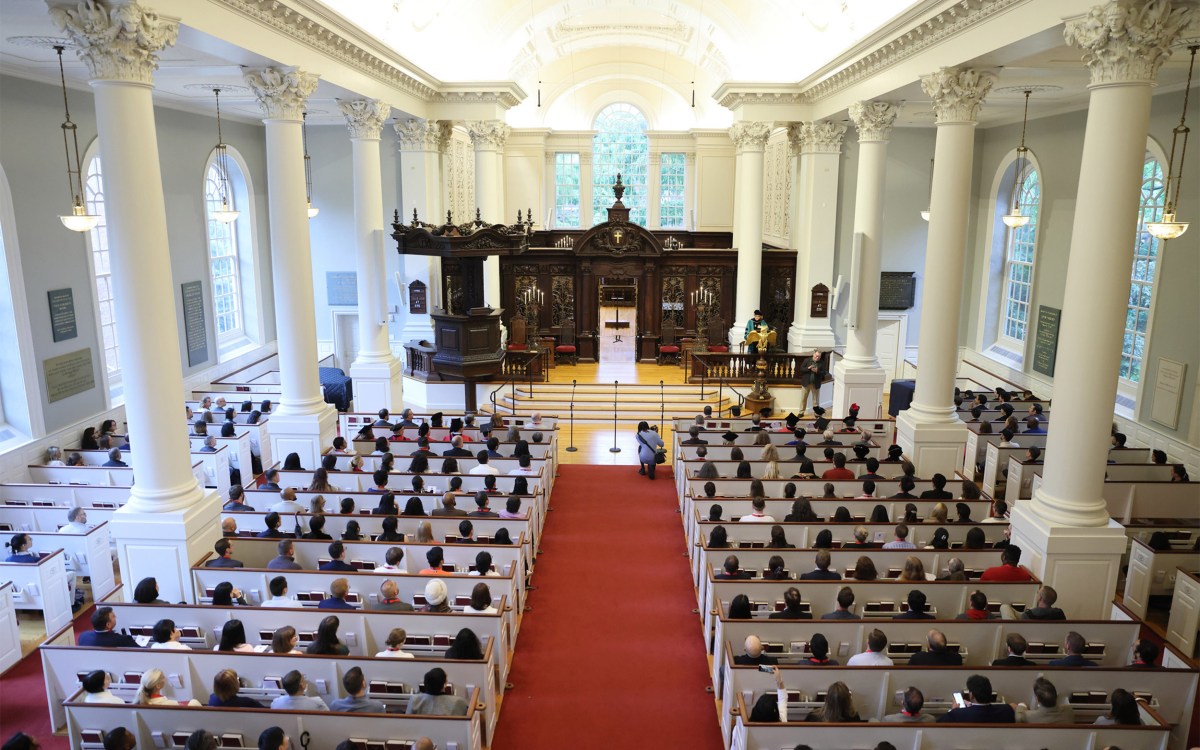Conservation progress the fruit of many Harvard hands
Seven years into the new millennium, Harvard has taken steps to lessen its impact on the environment. These are already bearing fruit, putting the University at the forefront of the national move to create environmentally friendly practices, buildings, and institutions.
To date, the University has scored a number of firsts and milestones in its initial steps toward creating a more environmentally sustainable campus. Notably, Harvard received an A- rating from the Sustainable Endowments Institute — one of only four U.S. universities to do so out of more than 100 evaluated.
Campus leaders have also reaffirmed their commitment to making Harvard a national model of an environment-friendly university.
“The issue of sustainability is crucial to Harvard and to the future of this planet,” said incoming President Drew G. Faust, dean of Radcliffe and Lincoln Professor of History. “As a University we have the opportunity to contribute to solutions in a variety of ways through our research, our teaching, the energy and creativity of our student body, and the dedication of our staff seeking practical solutions to everyday problems.
“Understanding and practicing environmental responsibility,” she added, “must be a priority for Harvard in the years to come.”
University-wide steps taken toward sustainability so far include the installation of energy-efficient lighting along with computerized heating and cooling systems in buildings.
Kitchen refuse is being composted and rainwater cached for washing University vehicles. Native plants are considered for landscaping needs. Renovations are designed with an eye toward saving energy and cutting waste, and new buildings are being designed to gain Leadership in Energy and Environmental Design (LEED) environmental-friendly certification.
Outreach programs in offices, laboratories, and dormitories include a sustainability mantra: recycle and reuse. Shut off lights and turn off computers when away.
Clean energy has become part of the campus power mix. The Harvard School of Public Health buys wind power certificates to reward student conservation pledges, and the University is contracting to buy clean energy attributes from the Massachusetts town of Hull’s wind turbines.
Overall, 7 percent of Harvard’s energy comes from renewable sources as the University offsets its greenhouse gas emissions from electrical consumption through the purchase of renewable energy certificates. Designers now as a matter of course consider how to include clean energy into the mix for the University’s extended campus in Allston.
There are problems that still have to be overcome, including the inefficiencies built into Harvard’s traditionally decentralized purchasing practices.
One major challenge yet to be met will be offsetting the rapid pace of construction in the years to come. However successful conservation activities have been so far, the increased growth of Harvard’s campus, with new buildings and a larger workforce, will test the University’s commitment to environmental sustainability.
The drive to make Harvard a cleaner and greener place comes from many sources. Faculty members teach and conduct research on everything from green roofs to global warming. Harvard’s Green Campus Initiative, an interfaculty initiative working with students, staff, and faculty alike across the University, has proven an important catalyst, guiding, partnering, cajoling, and — with the help of a $12 million revolving loan fund — making the practical argument that green practices save money.
The Harvard Center for the Environment fosters environment-centered research, hosts cross-faculty dinners, and sponsors talks by important players in the energy industry. The center supports research directly with grants, and through a new fellowship program that brings postdoctoral researchers to Harvard to pursue environment-centered projects.
In the past few years, the President’s Office has provided critical funding for Harvard’s sustainability efforts. The Harvard Green Campus Initiative loan fund was established in 2000, then twice expanded.
University staff and students have helped, ferreting out sources of waste and designing new ways to conserve, recycle, and save.
“The energy and excitement of Harvard’s faculty, staff, and students has proven contagious,” said Harvard interim President Derek Bok, “creating a broad-based movement to lessen Harvard’s impact on the environment that has made real progress in recent years.”
A leadership position
Outside organizations have noticed what Harvard is doing. In 2003, the U.S. Environmental Protection Agency (EPA) recognized the John F. Kennedy School of Government and the Faculty of Arts and Sciences for their energy conservation efforts.
In 2004, Cambridge awarded Harvard its Go Green business award for efforts to preserve the environment and the quality of life in Cambridge. In 2005, the University won the Green Power Leadership Award from the EPA, the U.S. Energy Department, and the nonprofit Center for Resource Solutions.
And in April, the American Forest and Paper Association gave its 2007 recycling award to Harvard for its schoolwide paper recycling efforts, which reclaimed 2,616 tons of paper fiber between July 2005 and June 2006. It was a team effort, said Rob Gogan, University Operations Services’ supervisor of waste management. “We have got building managers, custodial people, student advocates,” he said. “It’s really about partnership.”
Kris Kiser, the executive director of the association’s paper sector, said the association is actively working to boost American recycling rates to meet growing global demand. The association wants to hold Harvard up as an example of a successful program in hopes other colleges and universities follow its example.
Across the University, recycling rates have steadily pushed upward, reaching 48 percent in March. Meanwhile, the amount of waste generated has fallen — by 10 percent in January, February, and March compared with the same three months a year earlier.
Creating a ‘Green Campus’
In a watershed moment, then-President Neil Rudenstine in 2000 provided seed funding for the Harvard Green Campus Initiative (HGCI). Leith Sharp was recruited to Harvard from Australia (by HGCI co-chairs Jack Spengler, Akira Yamaguchi Professor of Environmental Health and Human Habitation at the Harvard School of Public Health, and Associate Vice President for University Operations Services Tom Vautin) to establish and direct this new University-wide program.
The initiative is a joint academic and administrative venture, making it “still unique among campus sustainability programs,” Spengler said.
From a lone director in a single office at 38 Oxford St., the organization has grown steadily. Today it has a staff of 20 full-time professionals, and it initiates hundreds of money-saving green campus projects each year.
“The mission of the HGCI is to engage, support, and coordinate the entire University community in making Harvard a global model of campus sustainability,” Sharp said. “This is clearly not a job for one person, but is instead a job for thousands of people working in a coordinated fashion to achieve continuous improvement in the way we run our campus.”
The HGCI is physically located alongside Harvard’s University Operations Services in Harvard’s greenest building, a refurbished 19th century structure at 46 Blackstone St. Its recent overhaul remains a model of sustainability practices. During reconstruction, 99 percent of all construction and demolition waste was reused or recycled. Afterwards, energy use in the building dropped more than 40 percent.
This month, the United States Green Building Council awarded the 46 Blackstone St. building a platinum rating, the highest possible certification under the LEED green building program.
Several of last summer’s renovation projects reclaimed 93 percent or more of their construction debris. The Dunster-Mather kitchen renovation project donated old kitchen equipment for re-use. It also installed new, energy-efficient equipment: smart vent hoods that adjust air flow depending on how much food is on the stove; dishwashers that use less water; and machines that compost food waste and paper napkins.
Just a few years ago, Harvard building or renovation projects would incorporate one or two energy-saving features. Since then, the University has introduced a host of energy-saving and waste-reducing features into renovation projects and new construction.
Such change came about, in part, from Harvard’s adopting, in 2004, six Sustainability Principles to guide its planning and operations: Demonstrate institutional practices that promote sustainability. Promote native species wherever possible. Encourage environmental learning. Promote University health and productivity through building and campus design. Develop planning tools to assess and compare alternatives. And establish indicators to monitor success in meeting sustainability principles.
Across campus, 20 Harvard buildings are registered with the United States Green Buildings Council, the highest number of any campus in the country. In addition to the Blackstone project, the projects receiving LEED certification include Harvard Business School’s One Western Avenue and Hamilton Hall, 90 Mt. Auburn St., the Faculty of Arts and Sciences’ 60 Oxford St., the Radcliffe Institute for Advanced Study’s Schlesinger Library, and Harvard School of Public Health’s Landmark Center.
Adding clean power to the mix
In addition to their other sustainable features, fueling these and other campus buildings has been an increasingly clean mix of power. In 2006, a new fund was created with the aim of researching Harvard’s renewable energy options.
The three-year fund makes available $100,000 a year to invest in renewable energy research conducted by the HGCI. That includes wind power, ground source heat pumps, carbon offsets, deep well geothermal systems, biofuels, solar hot water, and photovoltaic systems.
A 36-kilowatt solar panel array, the second largest in Boston, was installed in 2003 on Harvard Business School’s Shad Hall. More recently, Harvard installed its first solar-powered trash bin, which uses the sun’s energy to compact waste. That significantly reduces the number of truck trips needed to pick up the trash.
The fund is also being used to purchase renewable energy certificates as part of Harvard’s annual Sustainability Pledge. Renewable energy certificates are awarded to University buildings in which over half of occupants pledge to do whatever they can to reduce their environmental impacts. In 2006, 20 buildings won renewable energy certificates.
Renewables are still more expensive than power from conventional fossil fuels. But Harvard uses a variety of credits and rebates to smooth its path toward the renewable energy market.
Last June, Harvard announced it would purchase the renewable energy credits from the town of Hull’s 1.8 megawatt wind turbine for the next 10 years. The credits allow clean energy producers to sell clean energy attributes to other power consumers. The agreement allows Harvard to meet state regulations. (It has to purchase renewable energy certificates equal to 2.5 percent of its energy requirements.) The agreement also supports renewable energy generation in Hull.
In addition to a fund for renewable energy, HGCI recently expanded the repayment terms of its Green Campus Loan Fund. That will encourage the inclusion of sustainable features in the design and construction of new buildings. Since its inception, the fund has directly financed and supported more than 130 conservation programs and projects. The average return on investment is over 35 percent because of energy conservation and other savings.
New construction and renovation projects can now fund the cost difference between a code-compliant design option and a high-performance design option as long as the payback is less than 10 years. This is coming online just as the University is drafting its own green building guidelines to set a new green standard for all construction and renovation at Harvard.
A unique opportunity
As Harvard embarks on its extended campus in Allston, the University recognizes that it has a unique opportunity to take a comprehensive approach in creating a highly sustainable campus, one that promises to be Harvard’s strongest expression of its commitment to sustainability to date.
University planners have developed a detailed set of Sustainability Guidelines for the campus in Allston. Architects of the first two projects being planned — the new science complex and an art center for the Harvard University Art Museums — are already incorporating forward-looking sustainability features in their projects’ designs.
Plans for projects beyond that are not yet finalized. But the University has committed to aim for a LEED gold certification for all future academic building in Allston. In addition, the University’s proposed master plan filed with the city of Boston includes a commitment to create more than 30 acres of open space on land now covered by asphalt. There are also measures to reduce energy consumption, carbon dioxide emissions, and storm water runoff. Street plans, with dedicated pedestrian walkways and bicycle lanes, encourage people power.
In addition to construction and renovation projects, smaller efforts at Harvard take aim at the consumption of materials and fossil fuels. University Operations Services has embarked on a wide range of projects. Included are those that improve efficiency, reduce emissions at Harvard’s steam plant, use rainwater to clean University vehicles, and clean buildings with low-impact cleaning products.
In 2004, the University became the first Ivy League school to use biodiesel — in this case, a mix of 20 percent soybean oil and 80 percent diesel fuel — as the primary fuel for its entire fleet of diesel vehicles. Because only one retail biodiesel pump existed in all of eastern Massachusetts, Harvard opened its own biodiesel filling station to supply its vehicles.
The battle for hearts and minds
A major part of Harvard’s progress in easing its environmental impact has focused on behavioral change.
Among its efforts are energy-reduction pledge campaigns; “trash mountains” constructed to raise awareness of what we discard; students employed in the dormitories to raise recycling rates and lower energy consumption; the Green Cup contest, in which Houses compete to be the most environmentally friendly; and cartoon and design competitions to help spread the sustainability message.
Faculty members across the University offer a host of courses dealing with the environment from many points of view. They often use Harvard’s own efforts — 46 Blackstone St., for one — to teach about sustainability, prompting students to think critically about the environmental problems that face a modern institution. Another Harvard demonstration site is the Graduate School of Design’s green roof.
The Harvard Center for the Environment is in the process of creating a 13-unit high school curriculum, complete with video lectures taught by Harvard faculty members. It should be available by fall 2007.
At the John F. Kennedy School of Government, faculty work on environmental policy and the intersection of the environment with critical governmental issues: energy supply, pollution regulation, and nuclear security.
Faculty at the Harvard School of Public Health, meanwhile, examine the role of pollutants on public health, while those at the Graduate School of Design examine the intersection of the built environment and the natural one. Members of the Faculty of Arts and Sciences are examining a broad array of questions involving the environment, from the basic science of living things in the Department of Organismic and Evolutionary Biology to the critical functioning of the planet in the Department of Earth and Planetary Sciences.
Faculty affiliated with the School of Engineering and Applied Sciences are examining practical aspects of humankind’s environmental footprint, such as ozone depletion and pollution transport.




